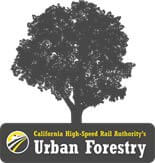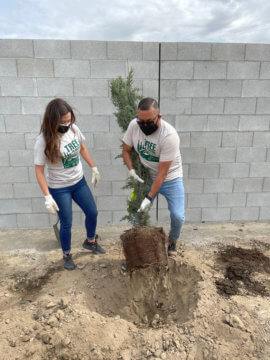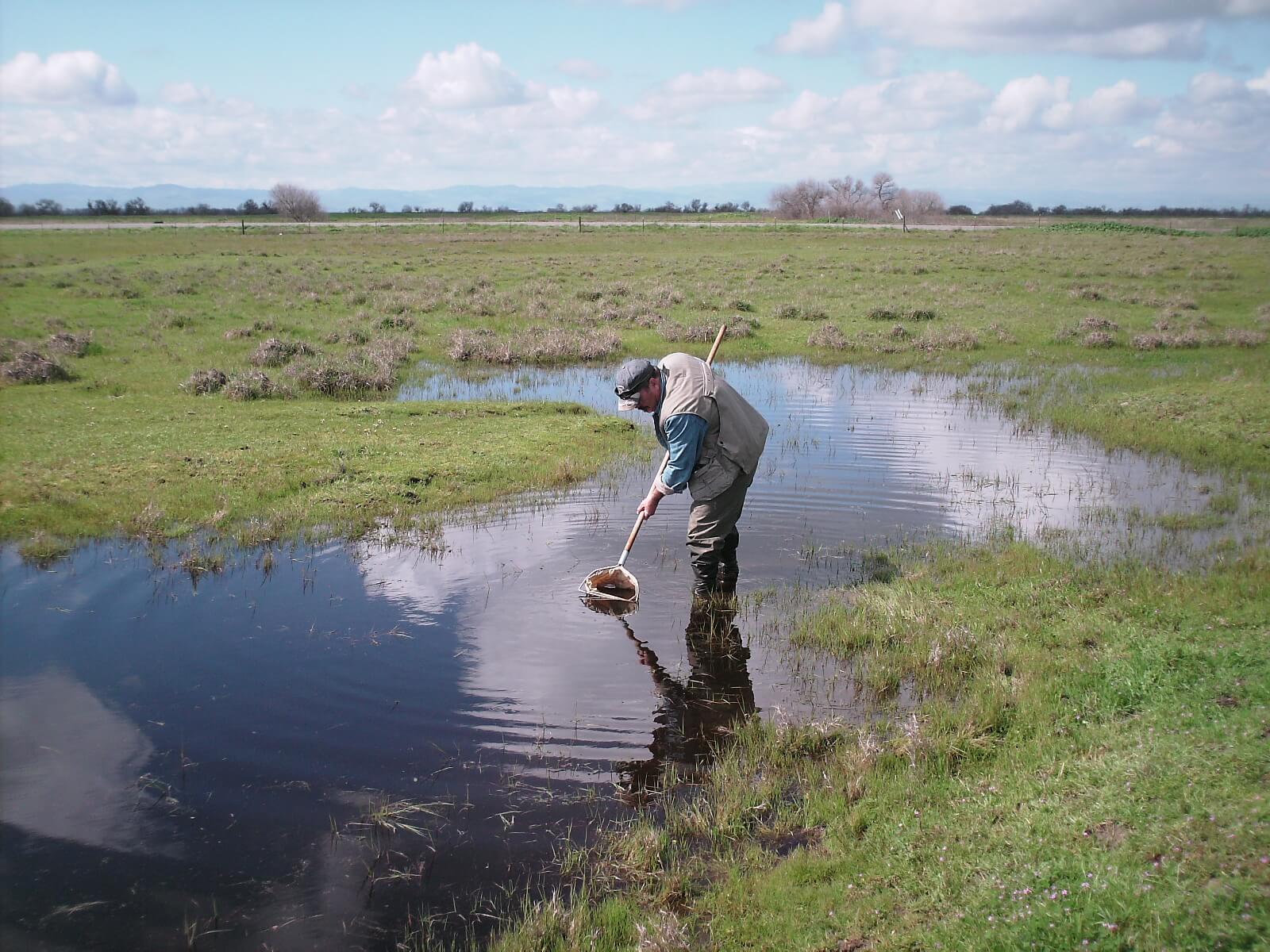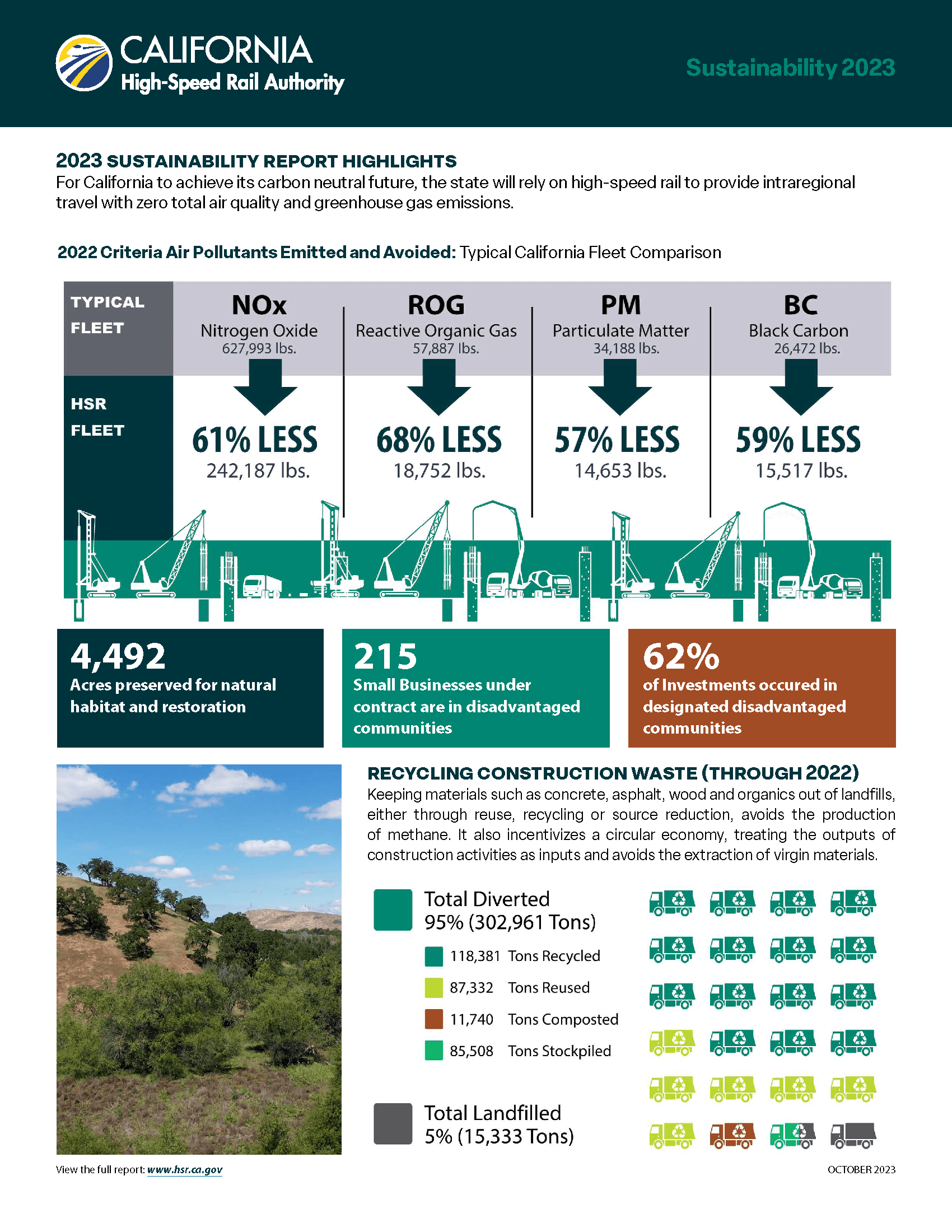Sustainability
Jump To
Building Clean, Green High-Speed Rail | Urban Design Guidelines | Sustainable Design Concepts |
Vision California | Urban Forestry Program
The term sustainability is often defined as the capacity to endure. Sustainability speaks to decision making that considers the impacts of the actions taken now, on future generations. When developing major infrastructure for the California High-Speed Rail Program, program designers must consider factors that safeguard the capacity of future generations to enjoy quality life:
- Environmental
- Economic
- Political
- Cultural
The California High-Speed Rail Authority (Authority) is committed to building a high-speed rail system that minimizes impacts to both the natural and built environment, encourages compact land development around transit stations, and helps California manage its pressing issues with climate change, traffic and airport congestion, and energy dependency. The Authority has adopted policies and published several documents that confirm a commitment to sustainable development.
- California High-Speed Rail Authority Sustainability Policy
- Memorandum of Understanding for Achieving an Environmentally Sustainable High-Speed Rail System in California
- Executed Memorandum of Understanding for Achieving an Environmentally Sustainable High-Speed Rail System in California
- Sustainability Implementation Plan
California is Building Clean, Green High-Speed Rail
- High-speed rail in California will be fully solar powered.
- The high-speed system will deliver a new utility-scale system on land it already owns that includes:
- 445 acres of solar panels
- Generating 44 megawatts of electricity and batteries
- To store 62MW/124 MWh megawatt hours of power
- The system will be able to propel trains to more than 220 miles per hour.
- The system must withstand the intense heat of the Central Valley and keep people moving, even if the grid goes out.
- With solar – HSR operating electricity costs can be cut by 75% annually, saving $14.3 million a year.
- Work could begin by 2026 to power trains by 2030 in the Central Valley.
Urban Design Guidelines
The California High-Speed Rail Authority’s Urban Design Guidelines are a comprehensive planning guide that provides domestic and international examples of station area design, urban design and transit-oriented development. This guide includes simple diagrams that analyze and explain successful public places and how each promotes livability and transit use. Urban design implemented around high-speed rail stations can encourage destination stations and enhance the value for the surrounding community.
The Urban Design Guidelines report is intended to be used by cities and communities throughout the state’s 800-mile system as they work with their stakeholders and residents to create a vision for their high-speed rail station areas.
Sustainable Design Concepts
High-speed rail will provide the Central Valley with improved access to the rest of the state, putting the Central Valley’s residents only one to two hours away from California’s major employment and population centers. This change in the Central Valley’s geography of access will in turn impact the course of future development within the region. At the regional scale, the increased accessibility afforded by high-speed rail can serve to concentrate development in and around communities that have stations. Such demand can shift the impetus of new growth away from the Central Valley’s agricultural land and reorient it towards established urban centers.
Vision California
“Vision California” is an unprecedented effort to explore the critical role of land use and transportation investments in meeting the environmental and fiscal challenges facing California over the coming decades. Calthorpe Associates is producing tools that can evaluate alternative physical visions for how California can accommodate anticipated growth. The project will model the consequences of varying land use and transportation scenarios, and quantify the benefits of a more sustainable, transit-oriented future for California–one that is anchored by a statewide high-speed rail network. To access these documents, please contact the Authority’s Public Records Act office.
- Vision California – Factsheet
- Vision California – Charting Our Future – Summary
- Vision California – Charting Our Future – Report
- Vision California – Charting Our Future – Rapid Fire Model Technical Summary
- Regional Demographic Summary Map
Urban Forestry Program

Honoring its commitment to zero-net direct greenhouse gas emissions in construction, the California High-Speed Rail Authority (Authority) is pleased to present the details of the first group of urban forestry projects. CAL FIRE, in partnership with the Authority, awarded $2.5 million in tree planting grants to offset greenhouse gas emissions associated with construction of the first portion of the high-speed rail system. In total, more than 7,000 urban trees were planted. A separate part of the agreement with additional funding also funded more than 1,800 acres of forestland planting. These trees will capture 143,000 metric tonnes of greenhouse gases over the project lifetime, while providing numerous environmental, social, and economic benefits to disadvantaged communities in the vicinity of the rail line between San Jose to Anaheim.
The urban forestry grants:
- Funded tree planting projects to reduce greenhouse gas levels
- Arrested the decline of urban forests and improved their structure and function
- Increased climate change resilience
- Improved the quality of the environment in urban areas
- Optimized co-benefits to urban residents
The interactive Urban Trees Map shows the locations of the urban trees, a summary of the eco benefits they will provide over the project lifetime, and the most common species planted. You can click on a species to show its benefits or click on an individual tree for more information about it.
GRANTS
Two organizations were awarded funding.
- Tree Fresno – $1 million grant
- 3,115 trees were planted in schools, parks, and in residential areas in disadvantaged communities in the greater Fresno region
- An emphasis was placed on planting the largest trees possible, as these provide the greatest greenhouse gas benefits
- Species were chosen wisely for drought tolerance and to make use of water-wise irrigation
- Educational opportunities, including curricular activities, were provided with the tree plantings
- Tree Fresno cared for the trees for the length of the grant and ongoing maintenance will be provided by the property owners
- Plantings began in spring of 2018 and concluded in the spring of 2021
- California Urban Forests Council – $1.5 million grant
- 4,063 trees were planted in disadvantaged communities along the rail corridor, half in public areas and half in residential areas
- CUFC worked to build a network of urban forestry support to create greener, cleaner communities by working with local partners in disadvantaged neighborhoods
- Informational and outreach opportunities were provided to engage residents and train volunteers in tree care
- Partners provided care for the trees for the length of the grant and ongoing maintenance will be provided
- Plantings began in spring of 2019 and were completed a year later
URBAN FORESTRY RESOURCES
The California High-Speed Rail Authority makes every effort to ensure the website and its contents meet mandated ADA requirements as per the California State mandated Web Content Accessibility Guidelines 2.0 Level AA standard. If you are looking for a particular document not located on the California High-Speed Rail Authority website, you may make a request for the document under the Public Records Act through the Public Records Act page. If you have any questions about the website or its contents, please contact the Authority at info@hsr.ca.gov.



